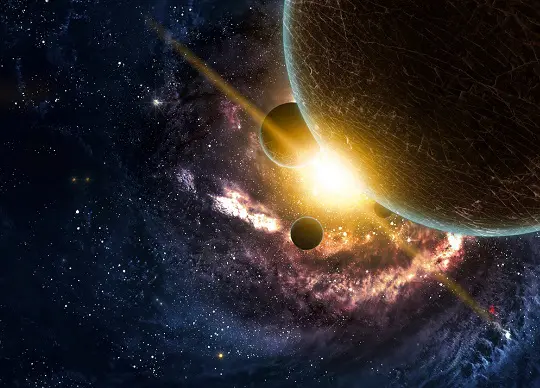
By Chris Flaherty
My Space Warfare Analysis Lab
INTRODUCTION
There are three-ways to look at Planetary Defence: (1) An Earth-Based defence system, that relies on Heavy Lift Vehicles to get a Nuclear Warhead, or Kinetic Impactor into Deep Space; (2) A Space-Based Orbital Battle Station armed with rockets, carrying Nuclear Warheads or Kinetic Impactors; and, (3) An Asteroid-Based Weapons System. The primary threat is defending the Earth from a collision with a Space Object large enough to devastate the planet, or end life on Earth. However, as we are now considering settlement – bases on the Moon, and Mars, the data from both the Lunar, and Mars Reconnaissance Orbiters, indicate these bodies, in particular the Moon are regularly bombarded by meteors. This either necessitates that a future Lunar Base is constructed sturdy enough to withstand a hit, or debris from a nearby surface impact, or the Moon has its own defence system. Likewise would the same be required for a future Mars settlement – base? Or is it the case, that all three bodies, the Earth, its Moon and Mars are protected by a common defence system? These questions will be addressed at the end of this paper.
This paper will look at two proposals one from China, and one from the United States looking at the potential design of an Earth-Based defence system, that relies on Heavy Lift Vehicles to get a Nuclear Warhead, or Kinetic Impactor into Deep Space, backed by a suite of large radio telescopes needed to direct the defence system. The paper will end looking at the broader political impact question arising from a Planetary Defence Program.
THE CHINESE PLANETARY DEFENCE PROGRAM
One of the recent Chinese space programme initiatives has been a proposal to set up a force of 23 Long March 5 (CZ-5) Rockets, on station to act as part of a Planetary Defence Program. The Chinese proposal also calls for a Planetary Defence System: made up of large radio telescopes across China able to track targets. The Chinese LM 5 (CZ-5) is its Heavy Lift Launch Vehicle, that weigh around 900 tonnes at take-off. It is a two-stage craft. The upper (second) stage would work as an Inter-Solar System Spacecraft, housing a Kinetic Impactor.

“▲ The Chinese Kinetic Impactor, mated with the upper (second) stage of the Long March 5 (CZ-5) Rocket. Shown here in its launch configuration, with its fairing nose cone (South China Morning Post/China National Space Administration Photo-Handout, 2021).”
Called an Assembled Kinetic Impactor, to differentiate it from an earlier concept, called the Enhanced Kinetic Impactor. The earlier Enhanced Impactor involved a Spacecraft launched to rendezvous with an intermediate Near-Earth Asteroid, collecting it, using this to deflect the target asteroid, by manoeuvring it into a collision. The Assembled Kinetic Impactor is presumed to be an LM 5 (CZ-5) upper stage. After its launch into Space, it would release its payload fairing (the nose cone used to protect a Spacecraft payload against the impact of dynamic pressure and aerodynamic heating during launch). The remaining propulsion unit, mated with the Kinetic Impactor, would then be set on an orbital patrol path within the Solar System, along with others acting as a Space Fleet of long-range Asteroid Hunter-Killer Spacecraft, travelling for years until the fleet began the attack on the target asteroid.
The Chinese preference is to use a Kinetic Impactor to change the course of an asteroid on an Earth collision course. The notion of using a Nuclear Warhead is not advocated as this could potentially blast the body into several fragments sending these into various paths, or perhaps remaining on their original course, becoming several threatening chunks. The Chinese proposal-concept is for a ‘Nuclear-free option’, using a force of 23 LM 5 (CZ-5), launched from various sites across China, at the same time. The fleet of Spacecraft would have to travel for almost three years to reach their target.
The LM 5 (CZ-5) upper stage is mated with a deflector: the Kinetic Impactor, and are presumed to be directed towards their intended target guided by the Planetary Defence System – suite of large radio telescopes. The Spacecraft’s excess fuel, left over from the upper stage burn intended to put it onto its orbital path would then be used as extra thrust during its flight towards the target asteroid. The upper stage fuselage is also used to increase the total mass of the deflector. Additionally, the upper stage would be modified adding a suite of small thrusters to complete proximity manoeuvrers in order to target the asteroid on its final trajectory. The Impactor device would be designed to avoid causing a break-up (of the whole body) on hitting the asteroid’s surface. Each Spacecraft would hit the asteroid’s surface in succession creating a series of gentle nudges putting it onto another course.
COMPARISON WITH THE U.S. PROGRAM
The Chinese Planetary Defence Program proposal is not new. There is also the 2018 NASA – National Nuclear Security Administration (NNSA) Spacecraft design called HAMMER: Hypervelocity Asteroid Mitigation Mission for Emergency Response. The HAMMER Spacecraft would be launched by a suite of Delta IV Heavy Rockets. The upper stage would release a HAMMER Spacecraft. Each of these would weigh 8.8 tons, and hit a target asteroid at an impact speed of 22,000 miles per hour. The proposed HAMMER Spacecraft had two modes. The impactor mode, that collides with the asteroid to gently nudge it off course (like the Chinese proposal). The second mode carries a Nuclear Warhead, relying on a detonation to destroy or deflect the target asteroid. The campaign plan would deploy a small fleet of HAMMER probes in the path of a target asteroid. Over the course of multiple impacts, the asteroid would be anticipated to slow down slightly, its orbital trajectory bent toward the Sun.
POLITICAL IMPACT
Potentially the campaign to destroy an asteroid threat would be long-term. It would begin after the discovery of the asteroid threat, some 25 years earlier, stated to be the lead-time by Chinese sources; that also contend their Planetary Defence System – suite of large radio telescopes, would have a much shorter lead-time reduced to a decade. However, if the discovery was much later, the U.S. HAMMER Spacecraft armed with Nuclear Warheads would be used. The Chinese Planetary Defence Program can be seen as a rival to the United States’ own NASA Double Asteroid Redirection Test (DART) Mission. It, like the United States’ version, is intended to put their country into global prominence as Earth’s protector. In many respects, the international impact, of having a Planetary Defence Program would set up a country as playing a ‘saviour role’ in world politics. Essentially, the discovery of an Earth collision scenario, and its public announcement – it should be noted that most science fiction dramas have assumed that this would be done in secret as some type of global conspiracy, would likely see international conflict over which country would take the lead, and which solution would be best. It would place the ‘winning’ country in a preeminent role in terms of global leadership, and prestige, having far-reaching economic, political, technology, and strategic implications derived from being the ‘big global issues problem solver’.
WIDER SOLAR SYSTEM PLANETARY BODIES DEFENCE
As Human’s expand their presence across the Solar System, the notion of Planetary Defence takes on a much wider set of possibilities. Such as the need for Lunar, and Mars Planetary Protection and Defence, in terms of the protection of surface activity, and settlement – bases, but also the possibility of large-body collision with either world. The consequences for Earth being struck by the debris from an impact on the Moon, or Mars suggests a much greater international involvement than any one country ‘saviour’. A proposal from 2002 looked at the Jupiter Trojans, at the L4 or L5 Lagrange Points as a potential site to host a permanent Space Base for missiles capable of deflecting the trajectory of dangerous Near Earth Objects. In 2021, there has been a proposal to build a massive Human Space-Habitat Megasatellite on Ceres: a dwarf planet, and the largest object in the Asteroid Belt between Mars and Jupiter. The concept included the notion it was armed with lasers, and kinetic kill vehicles, launched from it to protect from Space Objects on a trajectory, to collide with it.
From an international perspective, Planetary Defence can be a broad-based concept involving global integration of Space Forces dedicated to tracking Space Objects, building, operating and maintaining a Space Fleet of Asteroid Hunter-Killer Spacecraft, and stockpiled Nuclear Warheads, and Kinetic Impactors. The defence system envisaged, is not unlike that which underpins the current Superpowers, their Nuclear Deterrence capability, early warning and launch systems, and forces of Intercontinental Ballistic Missile. The future Planetary Defence System may well be based on the conversion of these forces, using Reusable Heavy Lift Vehicles, and upper stage craft that use new forms of propulsion guided by a globally integrated suite of large radio telescopes set-up across the planet managed by an International Space Force.
AUTHOR
Chris Flaherty authored the Terrorism Research Center’s report – Dangerous Minds (2012). He was the co-primary author, along with Robert J. Bunker of the book – Body Cavity Bombers: The New Martyrs (iUniverse, 2013). Two essays of his, from 2003 and 2010 were reprinted in the Terrorism Research Center’s book – Fifth Dimensional Operations (iUniverse, 2014). He recently contributed a book chapter – The Role of CCTV in Terrorist TTPs, edited by Dave Dilegge, Robert J. Bunker, John P. Sullivan, and Alma Keshavarz, the book – Blood and Concrete: 21st Century Conflict in Urban Centers and Megacities, a Small Wars Journal anthology, published on behalf of the Small Wars Foundation with Xlibris (2019). Chris Flaherty is currently a Space & Defense Tech and Security News Regular Contributor.
CONTACT DETAILS: Dr Chris Flaherty https://au.linkedin.com/in/drchrisflaherty
- REFERENCES
- • Janhunen, P. 2021 Terraforming the Dwarf Planet: Interconnected and Growable Megasatellite World. Elsevier (15 January).
• Li, M. Wang, Y. Wang, Y. Zhou, B. Zheng, W. 2020 Enhanced Kinetic Impactor for Deflecting Large Potentially Hazardous Asteroids via Maneuvering Space Rocks. Scientific Reports. Nature Research.
• Maccone, C. Bussolino, L. 2002 The “Trojan” Asteroids as Bases to Monitor Other Asteroids Potentially Dangerous for Earth. Journal of the British Interplanetary Society. Volume 55.
• NASA. 2021 Double Asteroid Redirection Test (DART) Mission. Fact Sheet.
• Jones, N. Steigerwald, B. 2016 Hit by Surprising Number of Meteoroids. NASA Press Release 16-33 (14 October).
• South China Morning Post/China National Space Administration. 2021. The So-Called Assembled Kinetic Impactor within China’s Long March 5 (CZ-5) Rocket. Photo-Handout.
• Wang, Y. Li, M. Gong, Z. Wang, J. Wang, C. Zhou, B. 2021 Assembled Kinetic Impactor for Deflecting Asteroids by Combining the Spacecraft with the Launch Vehicle Upper Stage. Icarus. Volume 368 (June).
• Whitwam, R. 2018 NASA Designs HAMMER Spacecraft to Deflect or Nuke Dangerous Asteroids. Extreme Tech.






